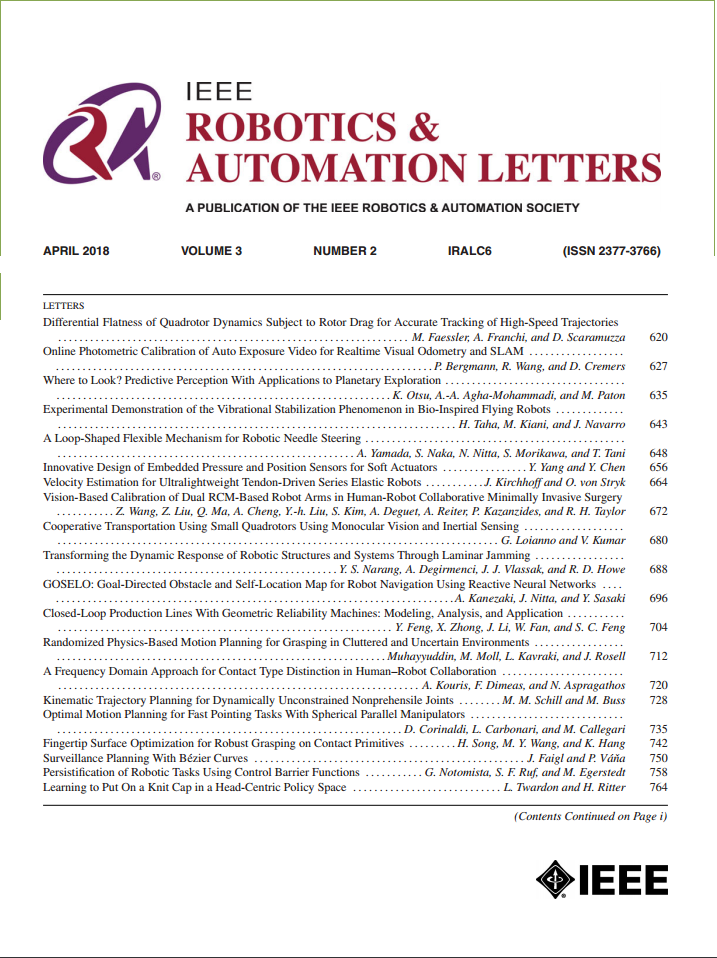快速学习、工具感知的协作机器人避碰
IF 4.6
2区 计算机科学
Q2 ROBOTICS
引用次数: 0
摘要
确保协作机器人在人类环境中安全高效地运行是一项挑战,特别是在障碍物运动和任务随时间变化的动态环境中。目前的机器人控制器通常假设完全可见和固定的工具,这可能导致碰撞或过于保守的行为。在我们的工作中,我们介绍了一种刀具感知防撞系统,该系统可以实时调整不同的刀具尺寸和刀具-环境交互模式。该系统利用学习感知模型,从点云中过滤出机器人和工具组件,对遮挡区域进行原因分析,并在部分可观测的情况下预测碰撞。然后,我们使用通过约束强化学习训练的控制策略,在10毫秒内产生平滑的回避机动。在模拟和实际测试中,我们的方法在动态环境中优于传统方法(APF, MPPI),同时保持亚毫米精度。此外,与最先进的基于gpu的规划器相比,我们的系统运行的计算成本降低了约60%。我们的方法为在动态环境中操作的机器人提供了模块化、高效和有效的碰撞避免。我们将我们的方法集成到一个协作机器人应用程序中,并演示了它在安全和响应操作方面的实际应用。本文章由计算机程序翻译,如有差异,请以英文原文为准。
Learning Fast, Tool-Aware Collision Avoidance for Collaborative Robots
Ensuring safe and efficient operation of collaborative robots in human environments is challenging, especially in dynamic settings where both obstacle motion and tasks change over time. Current robot controllers typically assume full visibility and fixed tools, which can lead to collisions or overly conservative behavior. In our work, we introduce a tool-aware collision avoidance system that adjusts in real time to different tool sizes and modes of tool-environment interaction. Using a learned perception model, our system filters out robot and tool components from the point cloud, reasons about occluded area, and predicts collision under partial observability. We then use a control policy trained via constrained reinforcement learning to produce smooth avoidance maneuvers in under 10 milliseconds. In simulated and real-world tests, our approach outperforms traditional approaches (APF, MPPI) in dynamic environments, while maintaining sub-millimeter accuracy. Moreover, our system operates with approximately 60% lower computational cost compared to a state-of-the-art GPU-based planner. Our approach provides modular, efficient, and effective collision avoidance for robots operating in dynamic environments. We integrate our method into a collaborative robot application and demonstrate its practical use for safe and responsive operation.
求助全文
通过发布文献求助,成功后即可免费获取论文全文。
去求助
来源期刊

IEEE Robotics and Automation Letters
Computer Science-Computer Science Applications
CiteScore
9.60
自引率
15.40%
发文量
1428
期刊介绍:
The scope of this journal is to publish peer-reviewed articles that provide a timely and concise account of innovative research ideas and application results, reporting significant theoretical findings and application case studies in areas of robotics and automation.
 求助内容:
求助内容: 应助结果提醒方式:
应助结果提醒方式:


